For many years we have suffered through The Fat Wars. We had a period in the mid-1900’s with unbridled fat consumption; households would use lard, beef fat (tallow & suet), bacon, eggs, and butter without a second thought. When the evil emperor (Ancel Keys?) associated these foods of plenty with our modern diseases, he was able to corrupt the government and companies into removing the animal-based saturated fats from our diet. The rise of the manufactured clone armies polyunsaturated fats were so overwhelming that they are nearly impossible to avoid. There was one glimmer of hope, the monounsaturated fats of olives (Anakin Skywalker) bridged the gap between the evil saturated-fat heart disease hypothesis (Dark Side) and the importance of real fat in our diet (Light Side). However, its legacy – Luke butter – must now finish the prophecy to bring balance back to the force fat. Can the heroes of this new saga bring a new era of saturated fat? The story continues…
It may take a while to fully wrap your head around the idea that saturated fat isn’t the enemy. There are a number of ways to do this – you can read the book The Big Fat Surprise by Nina Teicholz which chronicles the story of how saturated fat and the cholesterol-heart disease hypothesis came to rise through bad science, biased views, stubborn government, and big food agendas. Or you can read Good Calories, Bad Calories by Gary Taubes, which dives into and debunks the ideas that saturated fat conveniently causes heart disease, cancer, obesity, diabetes, and all of our “diseases of civilization”. They cover how the “heart healthy” polyunsaturated fats that have replaced the saturated fats in the Western diet are probably not helping our current epidemics of health. Both of these books provide compelling arguments that saturated fat is nothing to be feared.
After reviewing the literature above you might not be fully convinced that saturated fat is not culprit of all of our modern diseases. We may want to continue to hold saturated fat in jail as “guilty until proven innocent.” Especially since the real criminals of health are still out there running rampant. So then you may stumble into Grain Brain by David Perlmutter or Wheat Belly by William Davis which discuss the issues of refined carbohydrates and the damage they can wreak on our health. Or just pop in That Sugar Film and watch Damon Gameau’s health quickly deteriorate as he switches to a diet containing the average sugar intake of Australians.
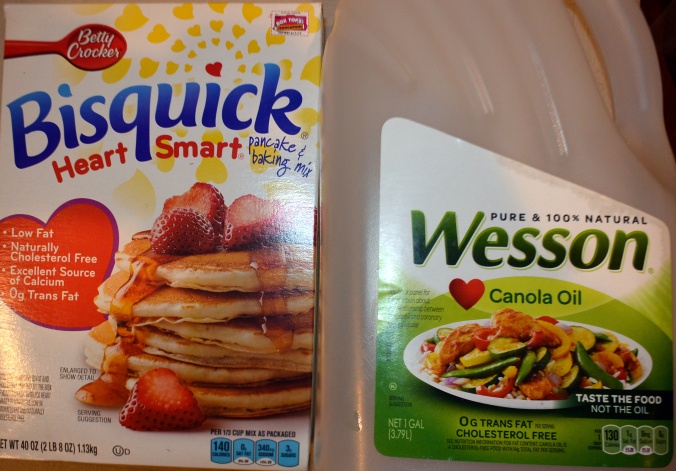
Two perfect examples of products marketed as “heart healthy” (see the giant hearts on them?) when their helpfulness to the heart is still heavily debated.
We may want to place blame on the fast food companies like McDonald’s whose rise in net sales and % of household spending skyrocketed during the era of the obesity epidemic. However we have to be careful of these epidemiological associations as that is what led us to falsely blame saturated fat to begin with. McDonalds and other fast food restaurants have complied with our saturated fat witch-hunt by systematically removing and replacing it with “heart healthy” polyunsaturated fats. However, the movie Supersize Me does compel us to also see that there is a potentially deadly combination of carbohydrates and low quality fats.
To fully convince myself I started a year-long diet experiment where I targeted the majority of my calories to come from fat, particularly saturated and monounsaturated fat. The results of that experiment have been phenomenal. My diet is more satisfying as I use foods like butter, coconut oil, avocados, and olives to curb hunger cravings. I’ve turned to ghee for frying which is stable at higher temperatures and imparts a delicious flavor in my food.
But what if butter and coconut oil are the gateway fats to harder (literally) fats? Do we dare to approach the dreaded animal-based saturated fats – the lard from pigs, tallow and suet from cows? These have been the most ostracized of all the saturated fats. Most of the early adopters for the saturated fat revival seem to easily accept back the vegetarian saturated fats such as coconut oil, palm oil, butter, and ghee. We are still a little squeamish about taking the next inevitable plunge.
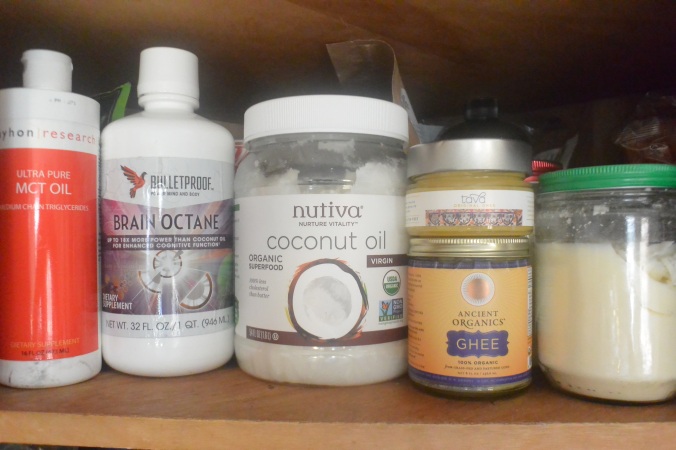
My current stash of saturated fats: MCT Oils, Coconut Oil, Ghee, and Tallow
Remember that not too long ago tallow was used in the fry oil of McDonalds and many restaurants. This oil is shelf stable, less prone oxidation, resistant to high temperature, and more rich and flavorful than the other fry oils available. When companies like McDonalds, Nabisco, Frito-Lay, and others had to remove the saturated fats from their products they had a difficult time finding alternatives that would impart the same taste. Having this fat is a great culinary boon to have in any well stocked pantry. The trick is finding it. It is currently a rarity in the supermarket, so the key is to obtain suet from a local butcher and render it yourself. If you are lucky enough to get your hands on this the process for rendering is very straightforward.
See the process here:
1. Obtain some nice hunks of suet. These have a waxy feeling cellophane around the outside. Trim off any excess meat or blood that may be on it.
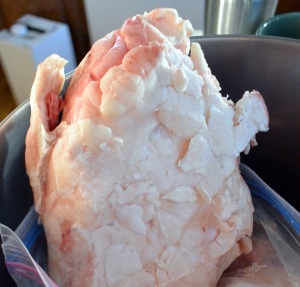
A hunk of suet! YUM!
2. Cut it into small pieces, or toss it in the food processor and give it a few good pulses. Put it all in a crock pot and start it on low and cover it.
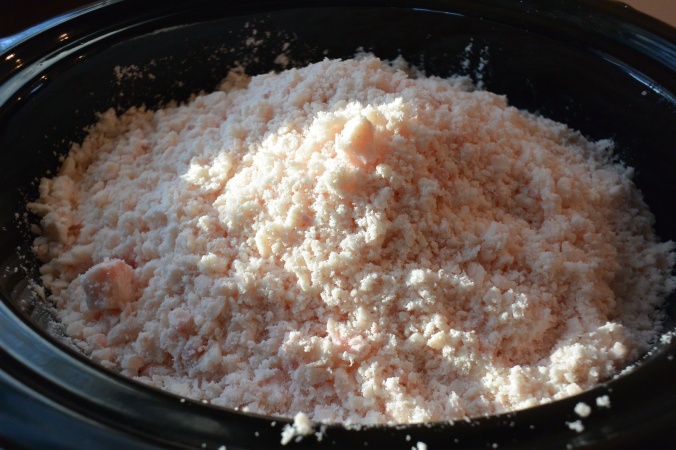
A pile of chopped suet in my crock pot.
3. Leave alone for a few hours, starting to stir occasionally when a good amount of liquid is formed.
4. After about 8 hours it will be fully rendered, with only some brownish floaties left in there.
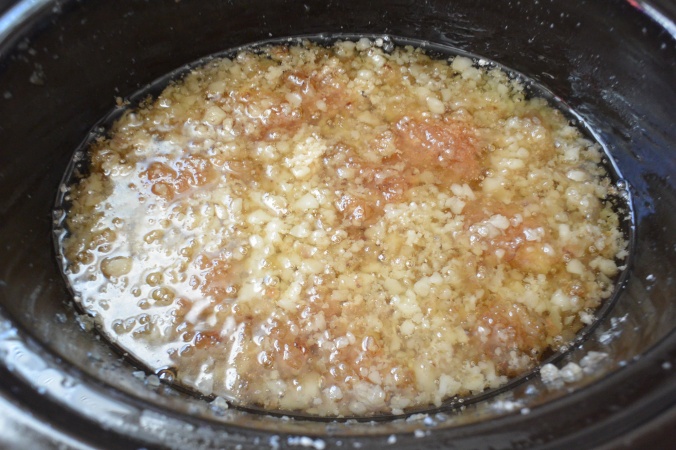
Here it is a few hours in, eventually there will only be the brown floaties left.
5. Pour into a glass casserole dish through a cheesecloth and a strainer, I used a nut milk bag. I caught the extra floaties in the nut milk bag (important for wringing out all the fat in the next step).
(no picture here, my hands were covered in grease at this time so I didn’t want to get it on my camera!)
6. Squeeze the remaining floaties (wrapped up in the cheese cloth or nut milk bag) to extract the last bits of fat from the suet, I did this by hand which was quite unpleasant due to the heat. Other websites recommend using a ricer to squeeze them out.
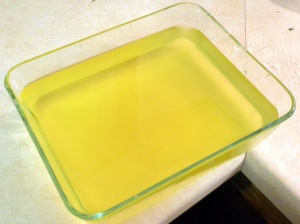
7. Allow it to cool on the counter, I do it overnight and loosely cover with aluminum foil.
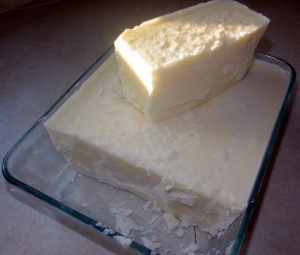
8. Put in the fridge for a few hours to make it easy to chunk apart with a knife. They can be easily bagged or re-melted into jars.
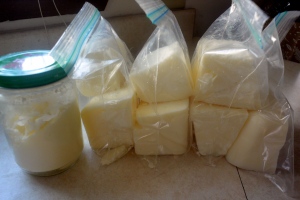
So there you go! A new saturated fat ready for use. Tallow is perfectly stable to stay on the shelf for months. If you don’t have access to suet then just make a batch of bacon and save the grease for later. Enjoy!
-Andrew